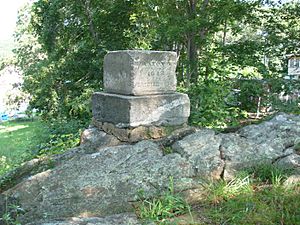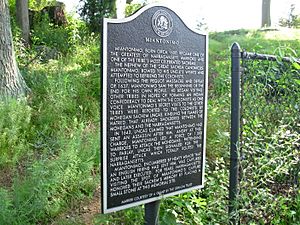Miantonomoh facts for kids
Miantonomoh (born around 1600, died August 1643) was an important leader, also known as a sachem, of the Narragansett people. The Narragansett were a Native American tribe living in New England. Miantonomoh worked closely with his uncle, Canonicus, who was the grand sachem of their tribe. Miantonomoh became the leader himself in 1636.
Contents
Miantonomoh's Life and Leadership
Early Years and Relations with English Settlers
Miantonomoh was the nephew of Canonicus, the main leader of the Narragansett tribe. He helped Canonicus govern the tribe and took over as sachem in 1636. Miantonomoh generally tried to be friendly with the English colonists. These settlers lived in places like Massachusetts, Rhode Island, and Connecticut.
In 1632, Miantonomoh and his wife, Wawaloam, even traveled to Boston. They went to visit Governor John Winthrop to show their good intentions. Later, in 1636, Miantonomoh visited Boston again. He wanted to prove his loyalty to the colonists, as some people suspected he might be planning against them.
The Pequot War and Peace Treaties
In 1637, a major conflict called the Pequot War broke out. Miantonomoh allowed an English leader, John Mason, to lead his soldiers through Narragansett land. These soldiers were on their way to fight the Pequot Indians. The Pequot tribe was defeated in this war.
After the war, in 1638, Miantonomoh signed an important agreement. This was a three-way treaty between the Narragansett tribe, the Connecticut colonists, and the Mohegan Indians. The treaty promised lasting peace among them. Miantonomoh was given control over 80 of the 200 Pequot people who survived the war.
Growing Conflicts with the Mohegans
Even after the treaty, problems continued with the Mohegan tribe. Both the Narragansett and Mohegan tribes wanted control over the Pequot people and their lands. Miantonomoh tried to unite other Native American tribes in the New England area. His goal was to form a strong group that could stand up to the colonists.

The disagreements with the Mohegans eventually led to war in 1643. Miantonomoh led nearly 1,000 Narragansett warriors into Mohegan territory. However, his forces were defeated. Miantonomoh was wearing heavy armor, which slowed him down. Because of this, he was captured during the battle.
Capture and Death
After his capture, Miantonomoh suggested an alliance against the colonists to the Mohegan leader, Uncas. But Uncas did not agree. Instead, Uncas took Miantonomoh to Hartford. He wanted advice from the Colonial Commissioners on what to do next.
The commissioners of the United Colonies of New England were unsure. They asked a group of five religious leaders from Boston for their opinion. Even though Miantonomoh had gone to war with some colonial consent, the clergymen suggested he should be killed. They admitted they did not have the official power to order this.
Miantonomoh was taken back to Norwich, where he had been defeated. There, he was killed with a tomahawk by Wawequa, who was Uncas's brother.
Miantonomoh's Family
Miantonomoh had a younger brother named Pessicus. His son, Canonchet, also became a Narragansett sachem. Miantonomoh also had a daughter or granddaughter named Minnetinka. After her mother died and Miantonomoh was killed, a Dutch family raised and educated her. She later married John Corey and was known by her Christian name, Elizabeth Gasesett.
Miantonomoh's Legacy
- Miantonomoh was honored in 1997 by being added to the Rhode Island Heritage Hall of Fame.
- Four ships in the United States Navy have been named after him. Two were called Miantonomoh and two were called Miantonomah.
- There is a monument dedicated to Miantonomoh in Sachem's Park, located in Norwich, Connecticut.
- Miantonomi Memorial Park in Newport, Rhode Island is named after him.
- A street in Middletown, Rhode Island, is named after him and his uncle, Canonicus.
See also
 In Spanish: Miantonomo para niños
In Spanish: Miantonomo para niños


